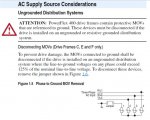Shujinko
Senior Member
I have a project where the existing pad mounted utility transformer is configured as delta-delta. The utility company says it is an un-grounded delta secondary at 480V/3-phase/3-wire system. I asked them to take voltage readings between phase-phase and phase-ground just to make sure it is an un-grounded delta secondary. They sent me back readings for phase-phase at 480V, but phase-ground measured approximately 277V for each leg. I was expecting the phase-ground measurement to be 0V on an un-grounded delta system. The utility company says it is definitely not a 480Y/277V system and the interior of the transformer has no neutral connection.
I have heard of lightly loaded utility transformers having other than 0V on phase-ground for un-grounded delta systems as the there is a capacitive effect between phase-ground.
Anyone have some insight on this issue as to why there would be a 277V measurement on phase-ground in-lieu of 0V? The utility company is pretty unresponsive.
I have heard of lightly loaded utility transformers having other than 0V on phase-ground for un-grounded delta systems as the there is a capacitive effect between phase-ground.
Anyone have some insight on this issue as to why there would be a 277V measurement on phase-ground in-lieu of 0V? The utility company is pretty unresponsive.


